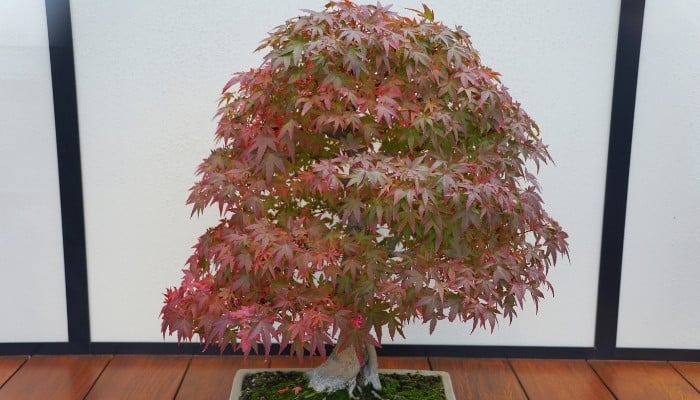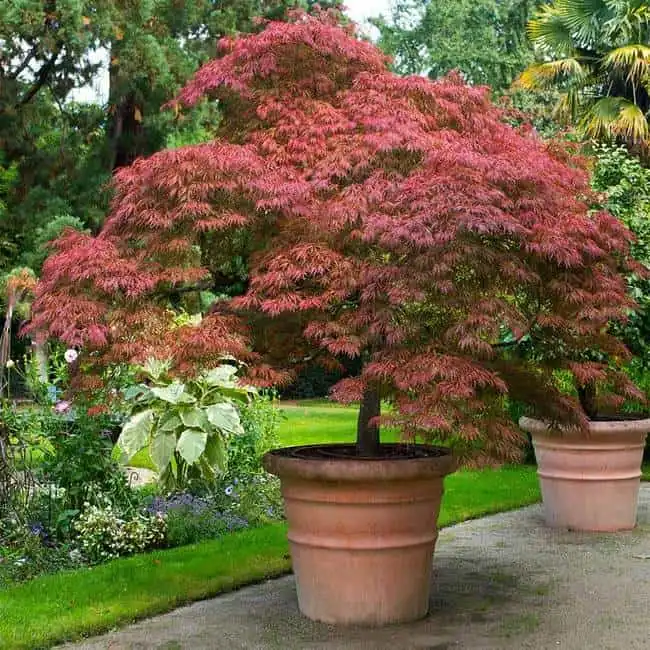Incorporating majestic shades of red, orange, gold, and soft pink, maple trees have the ability to completely enhance the surroundings they occupy.
Reaching heights of 30-100+ feet, maples add drama to mountainsides and riverbanks across North America and parts of Southeast Asia – so imagine the drama these colossal shrubs might add to your humble home!
Can you grow a maple tree indoors? It is possible to grow a maple tree indoors if its seasonal needs are met and effort is made to control their natural size with regular root trimming to stunt its growth. Small Japanese maple tree varieties in particular are suited to indoor potted growth and can tolerate milder climates.
If you’re an intermediate plant keeper, growing these breathtaking trees inside your home shouldn’t be too complex, as long as you have the appropriate tools and respect their annual cycle.
From choosing your variety to watering and controlling growth, we’ll take you through each step of growing a maple indoors.
How To Grow a Maple Tree Indoors
Step 1 – Selecting Your Maple Tree
Dwarf varieties of the Japanese maple tree are ideal as these develop smaller root systems and mature at 3-10 feet tall.
To maintain its health, you’ll need to choose one well suited to your location.
Most maples prefer a mild climate, so areas of the US with a plant hardiness zone of 5-9 (find out which zone you’re in here) will be perfect, though cold-hardy maples can tolerate lower zones.
Which Maple Trees Do Well in Pots?
- Red Dragon – compact slow-growing shrubs up to 5 feet tall and wide in zones 5-8. They are partial to direct sunlight and tolerant of frost.
- Velvet Viking – hardy and ultra-compact shrubs that mature at 4 feet tall and 5 feet wide. It’s tolerant of full sun and shade in zones 4-9.
- Ribbon-Leaf – dense, upright tree best grown in zones 6-9. It can grow up to 10 feet and is ideal for both container pots and bonsai.
Get a jump-start with a 1-2-foot or 3-4-foot starter maple tree, shipped right to you! Wide selection of maple trees and great customer service.
Step 2 – Potting an Indoor Maple Tree
Japanese maple expert John Heider of Wilson Bros Gardens recommends mixing the following soil recipe using a coffee can or small bucket as per your pot size:
- 3 parts quality potting soil – “aim higher than $1-a bag low-grade soils found at box stores.”
- 2 parts bark chips – “use orchid bark or pine chips to keep the soil slightly acidic as this aids in aerating the soil for better drainage and helps it to retain nutrients over an extended period.”
- 1 part pumice/perlite – this is lightweight volcanic rock material that “provides excellent water, air, and nutrient-retaining capabilities.” Agricultural-grade pumice is best – just wash the product beforehand to remove particles.
Wearing protective gardening gloves, pot your maple tree sapling in a pot twice its current size. Three-gallon pots are usually appropriate for dwarf maple saplings.
Remove your maple sapling from its existing container, and gently remove the soil from its roots.
Fill your new pot with soil mix, and make a hole for your sapling, placing it into the soil so that the top of its root ball system sits about 1 inch below the pot rim.
Add more soil until the pot is filled to the height of the top of the root ball.
Step 3 – Watering and Fertilizing an Indoor Maple Tree
Using room temperature water, water your tree once weekly throughout the year and every other day during summer, avoiding the leaves.
A morning watering is best so it doesn’t stay soggy overnight risking root suffocation, and water until the soil is moist but not soaked.
John B. of the Sky Nursery in Washington State, recommends slow-release organic fertilizer which “contains beneficial bacteria to help your maple absorb more water and nutrients.”
Apply this to your tree “once in mid-March and again in early July,” but don’t fertilize later in the season to avoid root damage.
Step 4 – Replicating Natural Conditions
Green-leafed maples can tolerate direct sunlight, while lacey/variegated varieties fare better in partial shade to prevent scorching.
Conservatories and rooms with large south-facing windows will be ideal, but growers on the Botanical Garden forum suggest “HID (High-intensity Discharge) lights to control sunlight intensity.”
Most maples prefer cooler temperatures and you’ll need to mimic their natural seasonal patterns by placing them outside for a few hours each night during spring/summer (keep them on a wheeled plant stand for convenience).
You’ll also need to help your potted maple enter its natural dormant cycle (around the end of October) and protect its roots from frost damage by either…
- Insulating the pot – create a closed fence around the plant using chicken wire and drop mulch and hay into the gap so you completely cover the tree from the ground up to the top of the pot.
- Storing in your garage – set up a microclimate in an unheated garage over winter according to the hardiness zone of your specific maple variety.
- Planting it in the yard – if you have the space, the best way to protect the roots and replicate its natural dormancy is to bury your maple (pot included) in the earth and cover the top with mulch for extra insulation.
Step 5 – Controlling Growth on a Maple Tree Grown Indoors
Using clean heavy-duty pruning shears, cut any broken or diseased-looking branches (soft or discolored bark) and prune back decaying leaves during summer when you can see its full shape.
Over time, the roots will begin to push against the sides and bottom of the pot beyond the drainage holes.
If you’re happy for your maple tree to grow taller, you should only trim the roots every couple of years using heavy-duty root-pruning shears.
How Do You Keep a Maple Tree Small?
If you want to control growth, you can begin stunting it upon purchase as a sapling. Before potting it for the first time, carefully trim off 1/5 of the length of the roots.
To keep your dwarf maple stunted at this height indefinitely, slide the point of a small shovel inside the pot (about 1 inch from the rim) weekly, working your way around the entire pot.
Step 6 – Repotting an Indoor Maple Tree
Repotting should be done every 2 years between October and March when the roots are in their dormant state.
Your maple tree will need rehoming in a pot twice its size once the top leaves begin crisping, roots protrude beneath the drain holes, or the current soil is draining poorly.
- Before repotting ensure it has been watered an hour before to soften up the soil for easy removal.
- With the help of another person, loosen the soil around the edge of the pot and gently pull the tree out holding the base of the main stem.
- Add your ideal soil recipe to your new pot, and make a hole for your maple tree. Lightly pat the soil up to the top of the tree’s root ball – taking care not to compact it – and water it thoroughly.
Can a Maple Tree Be Kept Indoors Indefinitely?

Maple trees can be grown indoors for as long as you can control their yearly growth (2 feet on average) with branch/root pruning.
Their longevity indoors will depend on the following care choices:
- How timely you are with repotting to prevent root decline.
- Over-fertilizing, creating hard-to-control growth.
- Scorching delicate/variegated maples in direct sunlight.
- Disregarding dormancy needs, allowing the soil to freeze.
Maple Tree Bonsai
Though they require outdoor growth to thrive, bonsai maple trees are hugely popular in teaching beginners how to control potted tree growth and preserve the beautiful foliage of regular maple trees in miniature form.
Houseplant enthusiast Cori Sears of The Spruce recommends the Japanese maple bonsai in particular for its beginner-friendly care of “low sunlight needs and flexible branches that are easy to shape and prune.”
Related Questions:
Can You Grow a Maple Tree From a Branch?
New maple tree roots can be grown from a branch cutting by soaking the end in root hormones (I use this one) to aid development.
Branch cuttings must be taken in spring or early summer when they contain new growth and should be planted in a pot of moist soil for 8-10 weeks, by which time the branch should develop roots.
Alternatively, you could air layer a maple tree branch to propagate another tree. We explain how to air layer trees here.
What Trees Can Grow Indoors?
Tropical trees with greater sensitivity to colder temperatures and higher humidity needs tend to grow successfully indoors – these include the Norfolk island pine, Parlor Palm, umbrella tree, tree fern, large rubber tree plant, and Natal mahogany.
Conclusion
In summary, growing maple trees indoors is feasible and rewarding with growth control measures and consideration for their seasonal cycle (i.e. providing the right sunlight intensity and coaxing dormancy).
Due to its many stunning slow-growing varieties, dwarf Japanese maple trees are championed by growers the world over as the best type for successful indoor growth.



